Spatial light modulator apparatus and method
a technology of spatial light and modulator, which is applied in the field of microscopy systems, can solve the problems of inability to clearly view the object of interest, phototoxicity and/or photobleaching, and particularly troubling problems
- Summary
- Abstract
- Description
- Claims
- Application Information
AI Technical Summary
Benefits of technology
Problems solved by technology
Method used
Image
Examples
Embodiment Construction
[0049]Enabling examples of the present invention provided herein discuss an epi-illumination fluorescent microscopy apparatus. However, the ordinarily skilled artisan readily comprehends that the invention may be deployed in any type of illumination system utilizing fluorescent microscopy, and / or in non-microscopy applications involving fluorescent emissions. Those of skill in the art readily comprehend that the instant invention may be deployed with any type of stimulating light illumination system used for stimulating a sample to produce excited fluorescence and / or for confocal masking.
[0050]Achieving optimal image quality using a CCD detector requires that the sample being viewed possess an emitted light signal intensity that is within the linear range of the CCD. The present invention achieves this goal by adaptively modulating excitation illumination intensity on a pixel-by-pixel basis using a high resolution spatial light modulator, such as an LCD (liquid crystal display) or a...
PUM
| Property | Measurement | Unit |
|---|---|---|
| switching time | aaaaa | aaaaa |
| integration time | aaaaa | aaaaa |
| fluorescent | aaaaa | aaaaa |
Abstract
Description
Claims
Application Information
 Login to View More
Login to View More - R&D
- Intellectual Property
- Life Sciences
- Materials
- Tech Scout
- Unparalleled Data Quality
- Higher Quality Content
- 60% Fewer Hallucinations
Browse by: Latest US Patents, China's latest patents, Technical Efficacy Thesaurus, Application Domain, Technology Topic, Popular Technical Reports.
© 2025 PatSnap. All rights reserved.Legal|Privacy policy|Modern Slavery Act Transparency Statement|Sitemap|About US| Contact US: help@patsnap.com



